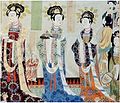Pibo
Appearance
| 披帛 | |
|---|---|
| Chinese name | |
Hanyu Pinyin | Pī bó |
| Transcriptions | |
|---|---|
| Revised Romanization | Phyo |
| Transcriptions | |
|---|---|
| Romanization | Hire |
Pibo (
Korean Peninsula, Japan, and Vietnam. Primarily worn by women, it is often draped over the shoulders or wrapped around the elbows. While crossing the arms, it hangs at the back, creating an elegant and graceful appearance. The ceremonial silk is also frequently seen in depictions of deities and immortals.[2]
Description

The 'pibo' (披帛) garment can be divided into two major types, 'pi' (帔) and 'bo' (帛), with lengths often exceeding two meters. The materials are delicate and soft silk gauze adorned with bright and colorful designs. Decorative patterns can be made using various methods, such as embroidery, dyeing, or printing.[1]
History
The Pibo likely originated from Persian kingdoms in
Hellenistic culture. It was possibly introduced to China via the Silk Road. It was particularly popular during the Sui and Tang Dynasty, where the silk pibo can be found both in the Western regions of Dunhuang and Turpan and the central region of Chang'an, reflecting the vibrant silk trade during that time.[3][4]
In the poetry, murals, and artworks of the Sui and Tang dynasties, fashionable women are often depicted draped in pibo silks.Five Dynasties, it became fashionable to loop the ceremonial silk from behind and then have it drape over the arm, requiring a pibo with a length of about five meters or more.[2]
Gallery
-
Female musicians wearing pibo, early Tang dynasty
-
Handamaiden wearing Pibo in early Tang dynasty, depicted on mural
-
Female wearing pibo in Guiyi Circuit
-
Male Bodhisattvas depicted in Pibo on murals in the Kizil Caves,Kingdom of Kucha(modern-day Xinjiang, China), 5th to 6th CE
-
Actors portraying Nara period court women draped in Japanese style Pibo
References
- ^ ISBN 9787510835384.
- ^ ISBN 9789571378473.
- ^ a b 中原文化家 (2019). "古代披帛起源於何時?". www.sohu.com.
- ISSN 1000-4106.





